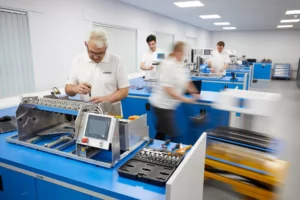28 May 2015; Nottingham, UK: New experimental studies using the Child Alberta Idealised Throat (C-AIT) from Copley Scientific confirm that it provides data more representative of in vivo throat deposition than the standard USP/Ph. Eur. induction port used for routine inhaler testing. The results echo those observed with the adult AIT (A-AIT) and indicate that both accessories have an important role to play in generating measurements that can be used to improve and/or target drug delivery by ensuring better in vitro in vivo relationships (IVIVRs). Better representation of deposition in the throat is recognised as a major concern in inhaled product testing, as evidenced by recent of FDA funding to support the experimental assessment of different mouth-throat models*.
A stronger relationship between in vitro measurements and in vivo behaviour enhances the value of test data in an R&D setting, most especially when applying a Quality by Design approach. The standard USP/Ph.Eur. induction port is specified in the pharmacopoeias for cascade impaction testing to measure the aerodynamic particle size distribution (APSD) of the active ingredient in all inhaled drug formulations. However, it is known to underestimate the amount of drug that deposits in the throat.
‘Improving the realism and relevance of mouth-throat models for inhaled product testing’ details back-to-back studies with both the C-AIT and A-AIT, and the USP/Ph. Eur. induction port. Tests were carried out with two commercially available inhalers – one metered-dose, the other dry powder. In all instances, the AIT accessories captured more of the emitted dose than the USP/Ph. Eur. induction port, most especially capturing a greater proportion of larger particles. These accessories, therefore, provide a more realistic measurement of both delivered dose and the particle size of that dose, a parameter that influences deposition behaviour in the lung.
The A-AIT and C-AIT are precision manufactured to extremely close tolerances and designed to interface with a wide range of cascade impactors. Manufactured in metal, they have a highly reproducible, human-like geometry which delivers performance that is validated against clinical data across a broad range of flow rates. The C-AIT, which was introduced following successful trials with the A-AIT, is specifically for testing products for paediatric use and has a geometry based on measurements of the upper airway from nine children aged six to 14 years.
To find out more about the research read the published paper at http://bit.ly/COPODD.
*https://grants.nih.gov/grants/guide/rfa-files/RFA-FD-14-022.html

CAPTION: The Child and Adult Alberta Idealised Throats provide a practical and realistic representation of the throat for inhaled product testing.
About Copley Scientific
Copley Scientific is recognised as the world’s leading manufacturer and supplier of inhaler test equipment and is a major provider of testing systems for other pharmaceutical dosage forms. The company is also active in detergent testing, air sampling and aerosol characterisation.
Copley Scientific’s pharmaceutical product range includes test equipment for delivered dose uniformity and aerodynamic particle size measurement of metered-dose inhalers, dry powder inhalers, nebulizers and nasal sprays; as well as tablets (dissolution, disintegration, friability and hardness) capsules, powders, suppositories and transdermals.
Copley Scientific has offices in the UK and Switzerland. The company works in partnership with aerosol particle science experts MSP Corporation in North America and also distributes MSP Corporation’s air sampling and aerosol characterisation products throughout Europe.
Serving the pharmaceutical and associated industries, Copley Scientific offers an extensive range of equipment for research, development and quality control, as well as full validation and aftersales services. This broad range of products is supplied and supported worldwide through a network of specialist distributors.







